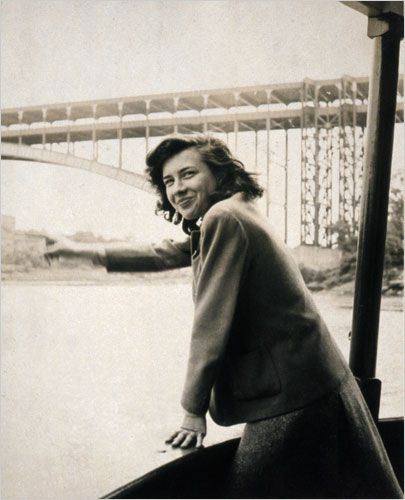
The New York Times (2009)
A clock strikes midnight with deep notes. A man clad in back drags a mysterious person’s body down a coiling staircase and a voice asks in Italian: “Who is there” while statues of angels and gargoyles, white as pearl against the night’s black sky, watch with interested expressions. This is the opening scene of Ripley, a neo-noir television show following the exploits of a con artist named Tom Ripley who, after committing a murder, covers his crime by taking his victim’s identity. This series was adapted from a book sequence written by Patricia Highsmith, a writer with a complicated story and personality which greatly impacted her uncanny style; she has been called one of the leading female writers of the 20th century.
Patricia Highsmith was a writer of novels and short stories. She is best known for her psychological thrillers, often told from the viewpoints of the criminals and exploring the psychology of her characters. Her best-known work is the series of books featuring the character Tom Ripley. Throughout the course of her life, Patricia Highsmith traveled from the United States to Europe, first in England, then in Germany, Italy, France, and finally in Switzerland; she spent the last years of her life in Ticino, Switzerland, where I was born, and where she was interviewed by the Radiotelevisione Svizzera in 1982. This interview, made in Italian and re-translated back into English for the purpose of this article, will be often mentioned as a source for Patricia Highsmith’s beliefs, ideas, and creative process.
Highsmith was born in Forth Worth, in Texas, on January 19, 1921. Her parents separated a few days before she was born, and she was raised mostly by her grandmother. Later in her life, when she was twenty-one years old, she moved to
New York; initially unable to sell her short stories, she made a living by writing plotlines for comics. After her first book, Strangers on a Train, was rejected by six editors, her mother gave her a mysterious advice: her style was not “open and cordial” toward her readers, and this made them feel “insulted.” In the interview, Highsmith stated that she still does not fully know what her mother meant, but that she still followed the reflections that flowed from this advice and was finally successful in publishing the book, starting her career.
The style of Highsmith is characterized by a deep focus on the psychology of the characters depicted, the complex intrigues that these characters make in order to commit or hide their crimes, and the consequences of the act. As a result, the plots of her novels often deal with crimes made under unusual circumstances. Tom Ripley steals the identity of his first victim, while in the book Strangers on a Train, two characters decide to carry out a crime that the other would want to commit, causing both of them to die without a motive. In the interview, Highsmith argues that she is not very interested in the motivations that lead a person to commit a crime because she feels that she cannot fully comprehend them; instead, she prefers to focus on the psychological effects that the crime has on the perpetrators, relating that the most interesting characters to her are those who feel more guilt. Moreover, another quality that sets Highsmith apart from other crime writers is that she rarely, if ever, describes the capture and punishment of the criminals in her stories, and she does not make a clear cut division between good and evil in the view of the world she provides; as Graham Greene once stated about Highsmith, this writer “created a world without moral endings…” or, in her own words, “for neither life nor nature cares if justice is ever done or not.”
Patricia Highsmith has also a strange view of the creative process. In the interview, she mentions that being a writer means “to have crazy ideas and attempt to write them in amusing ways.” In her way of working, she first has ideas about plots and characters and then slowly works on them as she writes them in words. This is reflected in the interview by the manner in which she talks about the character Tom Ripley. She refers to him as someone she met, not as her creation, at one point even saying “I fear that he may be a little bit psychotic.”
The television show adapted from the Ripley Series partly reflects the style of the author who created the original material. The protagonist Ripley has villainous traits, yet he is presented to the audience in a relatively sympathetic way. There is no heroic character or a specific boundary between good and evil. In addition, the show carefully outlines the psychologies of the various characters involved.
The birth of Tom Ripley’s character, described by Patricia Highsmith in the interview, is perhaps stranger than the very books in which he features, and it is also a commentary on the explosive manner in which Highsmith creates her characters. Many years prior to the interview, Patricia Highsmith was staying at a hotel in Positano, Italy. One morning, at six o’clock, she saw “a solitary personage” taking a
walk on the beach; Highsmith wondered what was he doing at such an unusual hour. She never saw his face, and she decided that he looked very grave, but also very mysterious. As a result, she started thinking about a story in which a character similar to the person she saw could be sent to Positano for a mission, and some years later this line of thought led to the first of Ripley’s books; we may never know the identity of this person, but it is likely that he may have originated the character of Tom Ripley even if he himself may have never known it.